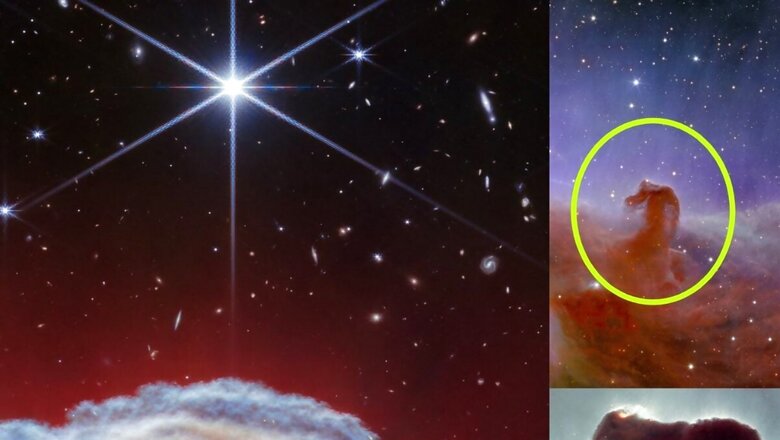
views
Nasa’s James Webb Space Telescope (JWST) for the first time captured hi-resolution, sharp images of the Horsehead Nebula. Nebulas are star-forming regions or stellar nurseries.
The Horsehead Nebula is located within the larger Orion Molecular Cloud Complex which is one of the nearest and most active regions of star formation in our Milky Way galaxy.
For the first time, the most powerful telescope ever placed into orbit around our planet, captured detailed images of the Horsehead Nebula, also known as Barnard 33, that were never seen before. These findings have shown some regions in an entirely different light.
The captured images show waves of gas rising from the western side of Orion B. The Orion-B is a star-forming molecular cloud located 1,300 light-years from Earth in the constellation of Orion.
The NASA/ESA/CSA James Webb Space Telescope has captured the sharpest infrared images to date of one of the most distinctive objects in our skies, the Horsehead Nebula capturing its complexity with unprecedented spatial resolution. pic.twitter.com/wW8BRAyeoq— Brian Roemmele (@BrianRoemmele) April 29, 2024
According to space.com, the Horsehead Nebula is a collapsing cloud of dense, cool gas. It remains illuminated because of a hot young star embedded in its top left edge.
The nebula is called a Horsehead Nebula because of its horse-like structure which also makes it very distinguishable from other celestial bodies. It was formed because lighter gas was eroded leaving behind a thick pillar of dense gas and dust that is harder to erode.
Scientists say that this thick dense matter will not last forever as the pillar of dense matter will be gone in around 5 million years.
An extraordinary zoom in on the iconic Horsehead Nebula, courtesy of @NASAWebb. In the new JWST image, you can see an entire cosmos of distant galaxies hidden behind the top of the horse's "mane"!https://t.co/EKOR40GhtK pic.twitter.com/ySMKEEFjJq— Corey S. Powell (@coreyspowell) April 30, 2024
The JWST’s Near-InfraRed Camera (NIRCam) instrument also clicked close-up photos of a small portion of the Horsehead Nebula. The photos show a curved wall of thick, smoky gas and dust with distant stars and galaxies behind it.
A large bright star is particularly evident in the photo and the JWST also managed to capture its distinctive diffraction spikes.
The other primary camera of JWST, the Mid-Infrared Instrument (MIRI), captured a small portion of the nebula revealing a stunning image with thick white and blue smoke punctuated by dark voids, space.com said in its report.
The Horsehead Nebula is a photon-dominated region (PDR) and the dense clouds of gas and dust serve as the birthplace for new stars. The PDR is an area of space where massive young stars warm up gas and dust between stars. Cold clouds exist between the hot ionised gas found closer to the newborn stars. PDRs exist between stars where gas is dense enough to block ionization but not so dense that ultraviolet light can’t penetrate it.




















Comments
0 comment